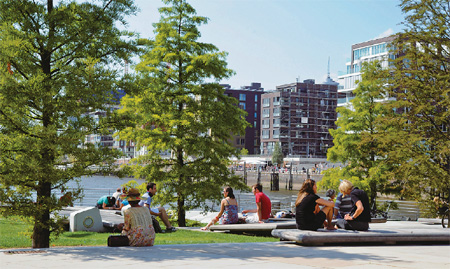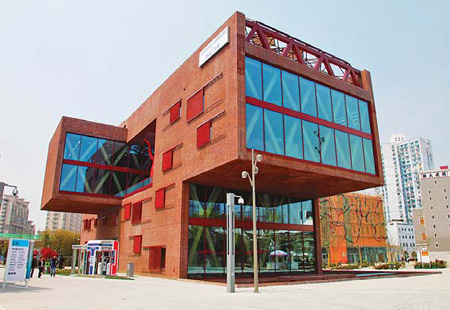Integrating waterfronts into city life
 |
|
A scene from HafenCity's expansive waterfront on the old harbor quarters of Hamburg, Germany. [Photo: China Daily] |
|
|
|
Hamburg House in the Puxi side of the Expo Park. [Gao Erqiang/China Daily] |
The redevelopment of Shanghai's Bund waterfront provides a lesson in urban engineering, but there is still room to improve the spatial integration of the city's housing and office space, particularly in Pudong, according to a leading executive from Germany's $10-billion HafenCity project.
"Waterfronts are one of the prime public features of a city that need to be developed very successfully, as the area of the Bund has shown," said Jrgen Bruns-Berentelg, CEO of HafenCity Hamburg GmbH. Hafen is the German word for "harbor".
"But if you go to Pudong, it is very much a commercial area, and it is to a very significant degree mono-structured. What we are trying to do (in HafenCity) is to bring in major companies, for example, into a more urban context, so it's not just a case of having one company next to another beside a major headquarters," Bruns-Berentelg said.
"At the end of the day, companies benefit from a more diverse environment. The benefits are also in terms of knowledge development as the companies can take some of the urban buzz or inspiration into their (tacit) knowledge base."
Bruns-Berentelg is overseeing HafenCity, Europe's biggest inner-city development project, which promises to expand Hamburg's city center by 40 percent and carve a 10.5-kilometer accessible waterfront. It broke ground in 2000 and is due for completion around 2025.
Bruns-Berentelg was recently in Shanghai to visit Hamburg House, a 4.2-million-euro ($5.29 million) pavilion modeled on the Sandtorkal 64 building in HafenCity. He said he hoped to draw inspiration from some of the other 51 case pavilions inside the Expo's Urban Best Practices Area (UBPA).
These showcase ways of building more people-friendly and ecologically aware cities as global urbanization approaches 50 percent this year and 67 percent by 2020-30. Most of the pavilions will be torn down when the Expo ends on Oct 31, but Hamburg House is likely to remain in Shanghai.
The block-like building is China's first certified "passive house," meaning that it uses a central ventilation system, photovoltaic roof panels, air pumps and other features to retain a year-round temperature of 25 degrees Celsius while slashing its energy use by 90 percent.
"It is a building at the highest level of environmental technology (that will) set new, higher ecological standards", says Anja Hajduk, senator of Germany's Ministry of City Development and Environment.
Hamburg, which is building a green area the size of London's Hyde Park in another of its districts, has already lowered its greenhouse gas emissions by 15 percent from 1990 levels. The EC in February named it European Green Capital 2011.
Bruns-Berentelg said city planners were facing many of the same problems that cities like Shanghai face, but that both were benefiting from rapid urbanization. The two cities have introduced rent-a-bike-schemes and are chasing new-energy construction projects to lower their respective carbon footprints.
"The growth rate seen here in Shanghai is a fundamentally positive basis for the transformation of a city in a more sustainable and ecological way. You can actually link urbanistic qualities and sustainability issues in a far faster way," he said.
"The ambition should also be set for the private investment to achieve those goals. I recently saw the potential of the city might not be used to the full degree, (it has) produced very broad streets and so on, so Shanghai, in the center, would be an excellent starting point to use this potential to a higher degree."
Like Shanghai, Germany is dealing with spiraling housing prices. HafenCity tries to balance this by offering subsidized housing. Residential land beside office space is therefore discounted by up to 50 percent per square meter.
The quarter also promotes the construction of low-rent cooperatives, and communities where 50 to 150 people share a common building and bring in architects to design their own house at a much lower cost, he said.
"This is an important way in which we mix our housing structure and our cultural structure, otherwise at the waterfront in HafenCity, for example, you would only have luxury housing, which is what we definitely want to avoid.
"That would lead to a non-sustainable social structure, and probably in five or 10 or 15 years a considerable number of these apartments would be left vacant and only used for speculative purposes as the expectations are that prices rise."
 0
0 







